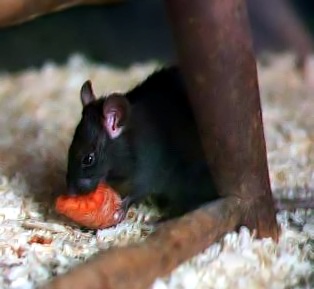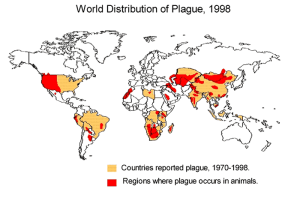
![Doctor Schnabel [Dr. Beak], a plague doctor in seventeenth-century Rome. Source: wiki commons](https://blogs.biomedcentral.com/bugbitten/wp-content/uploads/sites/11/2015/03/the-grim-reaper-217x300.jpg)
Contrary to many people’s understanding, the plague is not a thing of the past. Although it disappeared from Europe in the early 1900s it still persists in many pockets around the world (see map), as witnessed by the current outbreak in Madagascar. Analysis of DNA and immunoprotein samples from the remains of medieval plague victims has confirmed that the Black Death and subsequent plague epidemics were caused by the same bacterium, Yersinia pestis, as modern day outbreaks.
Shortly after Alexandre Yersin’s discovery, in the l890s, of the bacillus that caused the European plague pandemics, the accepted medical understanding was that plague was transmitted to humans from fleas infesting black rats; infected fleas thus acting as vectors. When rats began dying of the disease in large numbers infected fleas bit humans as an alternative host and thus infected them.
However the role of the black rat has been challenged by several investigators. For example, Anne Karin Hufthammer made a case against the involvement of black rats in plague epidemics in Scandinavia. She based her challenge on archeological information from bone assemblages that showed that black rats were very rare in medieval Norway, despite regular outbreaks of the plague. Indeed it is likely that the colder climatic conditions across Europe during this period would not have been conducive to the survival of populations of the black rat nor the Oriental rat flea, Xenopsylla cheopsis in most of Europe. The now common brown rat had not arrived in Europe at this time.
One of the places where the plague bacterium persists is in the Central Asian Deserts, where the great gerbil,  Rhombomys opimus, is the primary host. Gerbils are social animals, living in burrows infested with several parasitic arthropods, including the fleas that act as vectors for the bacterium. Gerbil populations fluctuate and the sylvatic plague bacterium will spread in the population when it exceeds an upper threshold level. Work published in 2007 by Nils Christian Stenseth and colleagues, who were studying the gerbil populations in Kazakhstan, suggested a co-dependency exists between climatic conditions, vegetation cover, synchronised increase in gerbil densities and plague transmission. Warm, moist conditions promote vegetation growth in these arid areas, giving rise to large gerbil populations and large plague epizootics. As gerbil populations crash, flea populations rise, the plague bacteria spread and infected fleas spill-over onto domestic animals and humans.
Rhombomys opimus, is the primary host. Gerbils are social animals, living in burrows infested with several parasitic arthropods, including the fleas that act as vectors for the bacterium. Gerbil populations fluctuate and the sylvatic plague bacterium will spread in the population when it exceeds an upper threshold level. Work published in 2007 by Nils Christian Stenseth and colleagues, who were studying the gerbil populations in Kazakhstan, suggested a co-dependency exists between climatic conditions, vegetation cover, synchronised increase in gerbil densities and plague transmission. Warm, moist conditions promote vegetation growth in these arid areas, giving rise to large gerbil populations and large plague epizootics. As gerbil populations crash, flea populations rise, the plague bacteria spread and infected fleas spill-over onto domestic animals and humans.
The latest study from this group has just been published. Here they asked whether climatic fluctuations were also responsible for the waves of plague pandemics that swept Europe after the initial Black Death of 1347-1353.
There are, of course, no reliable climatic records from the 13th / 14th century and so Stenseth and his colleagues used tree-ring based data as a climate proxy when looking for a relationship between climate fluctuations and plague outbreaks in medieval Europe.
They used historical records of 7,711 plague outbreaks that occurred after the Black Death and data from the analysis of 15 tree-ring based climate proxies taken across Europe and Asia. Unlike modern Asian outbreaks, no association could be found between plague outbreaks and climatic conditions.
Furthermore, there was little evidence that there was a local wildlife reservoir of Y. pestis that could have initiated new outbreaks. To determine this they selected outbreaks that occurred within 500 km of the location where one of the tree-ring samples had been taken and where, within a radius of 1000 km, there had been no previous plague outbreak in the past 2 years that could have been the source of the new outbreak. This analysis suggested that most outbreaks could be attributed to previous outbreaks nearby, as only 24 episodes remained that could only have been initiated by reservoirs of bacteria in the local rodent populations. In addition, 8 of these were historically documented to have been introduced with shipping from plague infested areas.
These findings caused then to turn their attention to the possibility that each new wave of disease had a maritime origin.
Using the same criteria to select locations, they were able to detect 61 potential maritime introductions that occurred between 1346 and 1856 in 17 harbours around the Mediterranean and the Black Sea coasts. These sea routes linked Europe with the overland routes to Asia. Historical reports were used to identify 16 potential introductions from Asia. Periods of climatic fluctuations were identified from tree ring analysis at sites on these ancient trade routes to Central Asia. Here populations of long tailed ground squirrels and Altai marmots are the rodent reservoir of plague.

They found that a period of approximately 15 years consistently occurred between a climatic fluctuation in the Karakorum mountain range in northern Pakistan and a plague reintroduction in Europe. This suggest a scenario whereby; 1-2 years after a climatic fluctuation, the rodent populations crashed and infected fleas sought alternative hosts. A period of 10-12 years followed when, they hypothesised, the disease travelled West via caravan routes to the sea (the ancient Silk Road). It took a further 2-3 years to spread into Europe via maritime trade routes.
Evidence for the spread via the ancient caravan routes requires further investigation but camels are easily infected with plague from the bites of fleas and the bacillus could also have travelled in infected traders, other animals or fleas in their cargo.
It would appear that we may need to rewrite the history books and place the blame for these ancient scourges that changed the face of Europe upon the trade in exotic goods rather than the humble rat.

5 Comments